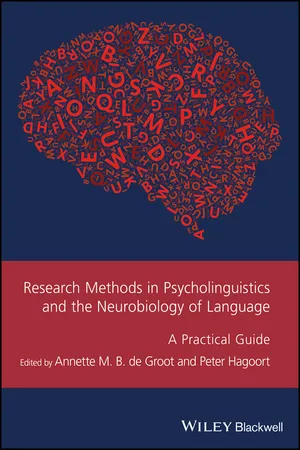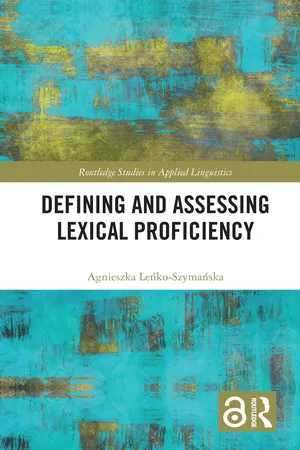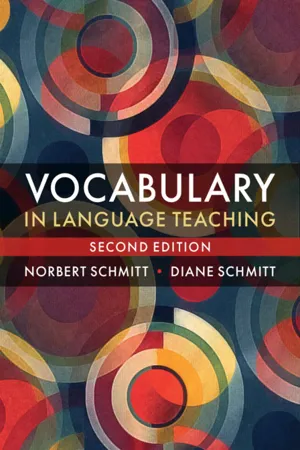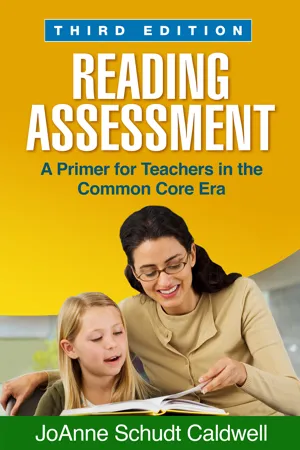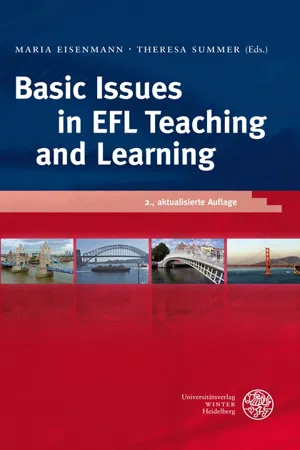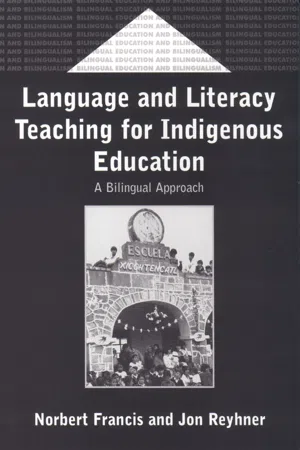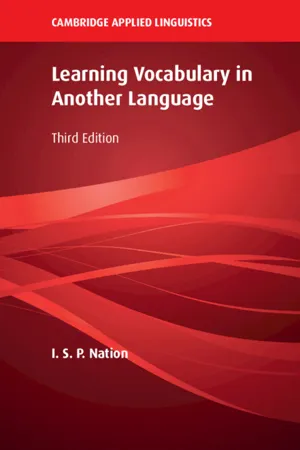Languages & Linguistics
Vocabulary Assessment
Vocabulary assessment involves evaluating an individual's knowledge and understanding of words in a particular language. This process typically includes measuring a person's ability to recognize, comprehend, and use a range of vocabulary words. Assessments may involve tasks such as defining words, identifying synonyms and antonyms, and using words in context to gauge language proficiency.
Written by Perlego with AI-assistance
Related key terms
1 of 5
10 Key excerpts on "Vocabulary Assessment"
- eBook - ePub
- Annette M. B. de Groot, Peter Hagoort, Annette M. B. de Groot, Peter Hagoort(Authors)
- 2017(Publication Date)
- Wiley-Blackwell(Publisher)
What we do know is that children in preschool can typically demonstrate knowledge of two or more meanings (e.g., watch as an action and watch as a device for keeping time) by identifying the correct meaning in specific contexts, without having conscious awareness of the ambiguity. These skills reflect metalinguistic awareness, which typically emerges around the beginning of school, and is the basis of much verbal humor. We have distinguished these aspects of meaning—and there are many others such as relationships among words (synonymy, antonyms, superordinates (Carroll, 2008))—to make clear that methods for assessing vocabulary knowledge vary in which aspects of meaning are addressed. Some Core Issues in Vocabulary Assessment We reserve the term “Vocabulary Assessment” for procedures that attempt to evaluate a learner’s lexicon quantitatively, as opposed to methods that are more focused on qualitative dimensions, such as specific components of meaning and relationships (networks) among words. The following distinctions should be kept in mind when considering assessment procedures: Is the goal to determine the overall size of vocabulary, or to obtain information about vocabulary composition? The latter is likely to require a longer procedure and careful design of lists. Composition has been most often analyzed with respect to syntactic or semantic subcategories of words, such as the contrast between nominals, predicates, and closed‐class words discussed above (Bates et al., 1994). A different analysis scheme, more often applied to parental input than to children directly, is common versus rare (or diverse) words (Weizman & Snow, 2001) - eBook - ePub
- Agnieszka Leńko-Szymańska(Author)
- 2019(Publication Date)
- Routledge(Publisher)
In the introduction to their book on language testing, Bachman and Palmer (1996) state that one best language test does not exist. The suitability of a test for a given purpose depends on many factors. One of these factors concerns particular uses that a test is supposed to be put to. Vocabulary Assessment has been performed within two areas of applied linguistics: foreign language education, and research in second language acquisition. Both domains, even though closely related, have different foci and different agenda. In consequence, Vocabulary Assessment performs a different function in each of these fields. In foreign language education it is an instrument for making decisions about learners and providing them with feedback on their abilities; in research on second language acquisition, on the other hand, it is a tool to gain a better understanding of the L2 learning process. Since both disciplines have different goals, the language tests they employ have to differ as well. In addition to being well grounded in the theory of language learning and testing, language tests used in education have to be, above all, practical. Thus, they have to be easy to administer and mark and their results have to be easily interpretable by test users. On the other hand, researchers are not concerned with issues of practicality. They usually use their tests with a limited group of people—research subjects—thus their instruments can be longer and more complex. Moreover, the results have to be meaningful only to the researcher himself or herself and a relatively small circle of other researchers in the area. Thus, while there has been some exchange of know-how between the two disciplines, the instruments employed by each field have been different.Read (2000) points out that both traditions in vocabulary testing have had their own weaknesses. On the one hand, language testing theorists tend to ignore the recent research in second language acquisition, which brings the lexicon to the centre of the second language learning process and they do not give enough importance to the assessment of learners’ lexical proficiency. On the other hand, second language acquisition researchers tend not to pay sufficient attention to most recent trends in testing concerning test validation. This section will discuss in detail vocabulary tests developed within both traditions. It will examine critically the purposes behind their design and the uses they have been put to. The strong points and weakness of each test will also be highlighted. - eBook - PDF
- Norbert Schmitt, Diane Schmitt(Authors)
- 2020(Publication Date)
- Cambridge University Press(Publisher)
. . . . . . . . . . . . . . . . . . . . . . . . . . . . . . . . . . . . . . . . . . . . . . . . . . . . . . . . . . . . . . . . . . . . . . . . . . 9 Assessing Vocabulary Knowledge • I am familiar with multiple-choice tests. What other kinds of tests are there to measure vocabulary? • How do I measure how many words my learners know, and also how well they know them? • How can I measure the vocabulary in my learners’ compositions and speech? When editing the book Vocabulary: Description, Acquisition and Pedagogy, John Read asked the lead editor why testing chapters always came at the end of books on vocabulary. This was a good question. It is certainly not because assessment is any less important than other aspects of vocabulary pedagogy. We concluded that it is partly because testing can be more technically complex than other aspects, but mostly because it requires an understanding of a wide range of vocabulary issues. Thus, the assessment chapter comes at the end of this book simply because it is the culmination and application of all the issues in the previous chapters. There are numerous reasons why vocabulary testing should be regarded as a useful element in a well-run language teaching program. Most obviously, if vocabulary is considered to be an important component of language know- ledge, then it naturally needs to be assessed in some way. Regardless of which of the four skills are being taught in a course, vocabulary knowledge will be one of the most important requisites in achieving proficiency. For some learners, particularly beginners, vocabulary may be about the only aspect of language they know well enough to be tested on. Another reason has to do with learner attitudes. Testing shapes the way learners view the content of a course. Most teachers are aware that learners partially judge the importance of classroom material by whether it appears on subsequent tests or not. This effect is called washback, and it can be positive or negative. - eBook - PDF
Reading Assessment
A Primer for Teachers in the Common Core Era
- JoAnne Schudt Caldwell(Author)
- 2014(Publication Date)
- The Guilford Press(Publisher)
It also includes usage or application of the word to a new context. A rubric can help the teacher to evaluate constructed response items. • • Application assessment activities include asking students to use the word in their own lives, matching parts of speech, and sorting words. • • Share with students the words that will be on the assessment. Explain how you will test their vocabulary knowledge. Make your assessment a parallel to class activities. Consider an open-book format for new and unfamiliar content. • • Instruct students how to infer word meaning from context and model the process for them. Vocabulary Knowledge 213 Activities for Developing Understanding • • Locate and download the Academic Word List (Coxhead, 2000). Choose a selection from a social studies or science text at your level and examine it for inclusion of words on the list. • • Select a social studies or science text and identify words that you consider unfamiliar to students. Examine the various forms of context provided within the text. • • Examine the teacher’s manual connected to a literature, social studies, or science text. Do you agree with the words that are signaled for instructional emphasis? What other words might you select and why? • • Select four words from a text and describe how you could instruct and assess these words in accordance with Standard 4. 214 APPENDIX 9.1 Questions to Ask about Vocabulary Assessments Published vocabulary tests are generally part of a complete assessment battery that can include decoding, fluency, and comprehension. A web search for terms that include “reading,” “vocabulary,” and/or “comprehension assessment” will lead you to many instruments both standardized and informal in nature. A search of publisher websites will also uncover example of Vocabulary Assessments. Your choice of a specific assessment depends primarily on your purpose. - No longer available |Learn more
- Maria Eisenmann, Theresa Summer(Authors)
- 2013(Publication Date)
- Universitätsverlag Winter(Publisher)
Testing/Test (* overlap with the term assessment ) Ź test: “designed to assess knowledge, skills, interests, or other characteristics of an examinee” (VandenBos 2006: 753) Alex Dawson, Wales/Cardiff University Approaches to the Teaching and Testing of Academic Vocabulary This article examines the correlation between students’ vocabulary gap-fill test results in the classroom, and their use of the target lexis in free writing compositions. Also investigated was the ability of the students to revise for the tests by using vocabulary cards and strategies autonomously. It was found that there was a wide range of results in the vocabulary tests, and that there was often little correlation between test results and the amount of words used in the free writing compositions. Research also revealed that students were largely unable to use their vocabulary cards effectively. Portfolio use may be a solution that forces students to focus on new lexis more explicitly and link new words back into the writing process. Portfolios can be suited and adapted for different institutions’ and students’ needs, and are an active testing tool that force students to participate actively in their testing process. 1. Introduction The issue of testing vocabulary can be problematic due to the sporadic nature of how it is taught, the stakeholders’ expectations of uptake and use, and opportunities to practise and perfect new lexis. Many educational cultures rely on memorising, translation and lists when teaching vocabulary, but when international students report this to practising EFL teachers, we tend to dismiss these techniques and insist upon strategies, autonomy, and experimentation with word families and synonyms. Testing lexical knowledge is easy inside the classroom with gap-fill tests, but it is more difficult to assess students’ reception and production of new words once they have finished one list of words and are learning a new set. - eBook - PDF
Language Assessment
A Cognitive Approach
- Prafull Dhondopant Kulkarni(Author)
- 2019(Publication Date)
- Society Publishing(Publisher)
Introduction to Language Assessment 1 CONTENTS 1.1. Introduction ........................................................................................ 2 1.2. Principles of Language Assessment ..................................................... 8 1.3. Development Assessment Process ..................................................... 11 1.4. Qualities of An Effective Assessment System ..................................... 14 1.5. Limitations of Traditional Test-Based Assessment ............................... 16 1.6. Technologies For Language Assessment ............................................. 18 1.7. Trends In Language Testing ................................................................ 22 1.8. Conclusion ....................................................................................... 25 References ............................................................................................... 27 Language Assessment: A Cognitive Approach 2 Assessment is defined as the process by which decisions are made regarding the knowledge and skills of a learner (Bachman, 1990; Lynch, 1996; McNamara, 1996). The word “assessment” is derived from the Latin word “assidere” that means, “to sit beside” and hence making the bystander able to observe the learner and collect the relevant information. Recently, the field of applied linguistics has inspected the skills, knowledge, and principles required for assessment known as language assessment literacy. This reflective chapter reviews the concept of language assessment and its need in today’s globalized world. To add to this construct, the chapter further concentrates on the specific principles involved in language assessment along with its development process. The chapter also defines the qualities of an effective language assessment systems and trends in practice today. - eBook - PDF
Researching Vocabulary
A Vocabulary Research Manual
- N. Schmitt(Author)
- 2010(Publication Date)
- Palgrave Macmillan(Publisher)
In most studies it is useful to take a measurement of the general vocabulary knowledge of your participants. This is usually done with a vocabulary size test (see Section 5.2). There are a range of such tests, with the Vocabulary Levels Test (Nation, 1990; Schmitt et al., 2001) being commonly used in second-language vocabulary studies. It samples English vocabulary at four frequency bands: 1,000 frequency level, 2,000 level, 5,000 level, and 10,000 level. It also includes an estimate of academic vocabulary. The entire test takes between 30 and 75 minutes to administer, depending on the examinee. However, it is not usually neces- sary to give all five sections. If given to beginners, certainly the 10,000 level, 162 Researching Vocabular y and probably the 5,000 level as well, should be excluded. They will provide little useful information, because examinees are likely to know very few of the words at these lower-frequency levels, and are only likely to become discouraged and frustrated in attempting them. Conversely , the 2,000 and 3,000 levels are good candidates for exclusion for advanced learners, as these examinees should obtain maximum scores at these levels. While they will not get frustrated by getting all of the items correct at these levels, a better use of time might be to measure more of the lexical feature you are focusing on in the study . Another example of the effects of frequency is in association tasks. In these, a stimulus lexeme is given, and participants asked to give one or more responses as quickly as they can (Section 2.4). The general behavior from a group of native speakers is that a small number of association responses are relatively frequent (e.g. for the stimulus sun: moon, shine) and a larger number e e of responses are relatively infrequent (warmth, ray ( ( ). However, the response y y behavior depends to a great degree on the stimulus lexemes. - eBook - PDF
Slavic Languages in Psycholinguistics
Chances and Challenges for Empirical and Experimental Research
- Tanja Anstatt, Anja Gattnar, Christina Clasmeier(Authors)
- 2016(Publication Date)
- Narr Francke Attempto(Publisher)
The second dimen-sion covers the range of vocabulary included in the task. If specific items selected by the scholar are the focus of the assessment, Read considers these vocabulary tests to be a selective vocabulary measure (ibid., p. 10). Compre-hensive measures of vocabulary, on the other hand, correspond to the con-cept of lexical richness. This general term includes lexical features such as lexical diversity (type-token ratio), lexical sophistication (the amount of low-frequency words) and lexical density (the ratio of lexical to grammatical words) (Daller et al., 2007, p. 13). Finally, the third dimension concerns the role of context in vocabulary tests. A context-independent vocabulary task presents lexical items in isolation without any context. A context-dependent vocabulary test, however, is “[a] vocabulary measure which assesses the test-takers’ ability to take account of contextual information in order to pro-duce the expected response” (Read, 2000, p. 9). 2.2 Types of psycholinguistic tasks 2.2.1 Picture naming tasks The picture naming task is a frequently used psycholinguistic tool for study-ing lexical access. Participants are asked to name objects presented on pic-tures as quickly as possible. The aim of this task is to measure the average reaction time for naming the depicted items. Another goal is to determine the level of picture-naming accuracy, which is measured as the percentage of correctly produced items. Two types of tasks can be distinguished according to whether the participants are granted a limited or an unlimited time span to deliver their answers. Picture naming tasks are generally easy to construct and to administer, and their results can be analyzed quickly. Another ad-vantage is that they can be used with little children and heritage speakers who cannot read (yet), as they are not dependent on literacy skills. - eBook - PDF
Language and Literacy Teaching for Indigenous Education
A Bilingual Approach
- Norbert Francis, Jon Reyhner(Authors)
- 2002(Publication Date)
- Multilingual Matters(Publisher)
The test results will also be related to his or her ability to use this vocabulary knowledge, for example, in telling a story or explaining a procedure. But it will be related to this expressive ability to a lesser extent, or in a much more indirect way, because other linguistic and cognitive skills each play an important role in higher-order uses of language. Here again, it would be a mistake to say that the test is invalid because an erroneous conclusion would be the result of misinterpreting the results. It would also not be correct to simply declare that our hypothetical test of vocabulary knowledge is completely invalid as a measure of the more complex ability since vocabulary knowledge does play a role. In other words, the results of the vocabulary test would reflect the more complex ability to a degree; we could argue that it does so to a limited degree, but this judgment is different from one that discards the results out of hand as “invalid.” Thus, in order to avoid misinterpreting assessment results, two ques-tions should be foremost in the bilingual teacher’s mind: (1) what aspect of language proficiency will the method that was selected hopefully reveal? (2) to what degree will the results reflect this aspect of language profi-ciency? All of this assumes, of course, that the aspect of language proficiency that was selected is an important learning objective in the first place. For a more complete discussion of the concept of validity, see Linn and Gronlund (1995: 47–80), Genesee and Upshur (1996: 62–67), and Kubiszyn and Borich (2000: 297–310). 164 Part 2: Curriculum and Materials, Classroom Strategies Reliability (1) Similarly to considerations of validity, reliability does not refer to the assessment instrument itself. However, in contrast to validity, when we consider questions of reliability we are not concerned with the interpretation of the results, but rather with examining the results themselves. - eBook - PDF
- I. S. P. Nation(Author)
- 2022(Publication Date)
- Cambridge University Press(Publisher)
These descriptions necessarily fragment knowledge that is all part of a strongly interdependent system. The justifications for this fragmentation typically relate to learning and testing. If we Table 13.3 A variety of test formats analysed using Read and Chapelle’s (2001) criteria Test Construct Design features Vocabulary Levels Test Vocabulary knowledge independent of context of use (trait) Discrete, selective, context-independent Lexical Frequency Profile Vocabulary knowledge independent of context of use (trait) Discrete, comprehensive, context-dependent ESL composition profile Ability to use vocabulary and academic writing (interactionalist) Embedded, comprehensive, context-dependent TOEFL vocabulary items (1995) Ability to cope with vocabulary in reading (interactionalist) Embedded, selective, context-independent Multiple-choice cloze Ability to cope with vocabulary in reading (interactionalist) Embedded, selective, context-dependent C-test (Singleton & Little, 1991) Vocabulary knowledge independent of context of use (trait) Discrete, selective, context-dependent Vocabulary Knowledge Scale Vocabulary knowledge independent of context of use (trait) Discrete, selective, context-independent Lexical density index Vocabulary knowledge independent of context of use (trait) Discrete, comprehensive, context-independent Vocabulary Size Test Vocabulary knowledge independent of context of use (trait) Discrete, selective, context-independent Word Associates Test Vocabulary knowledge independent of context of use (trait) Discrete, selective, context-independent 498 Testing vocabulary knowledge and use can isolate aspects of vocabulary learning, we may be able to enhance their learning and enable such learning to be tested. Looking at how well a particular word is known is called ‘meas- uring depth of knowledge’ which is contrasted with measuring how many words are known (breadth of knowledge), and strength of knowledge (how strongly each aspect is known).
Index pages curate the most relevant extracts from our library of academic textbooks. They’ve been created using an in-house natural language model (NLM), each adding context and meaning to key research topics.
